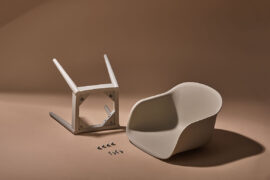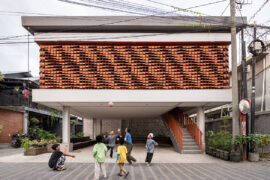A recent pilot CLT project in Japan by Junichi Kato showcases the benefits and appeal of CLT and hopes create demand for a sustainable and more sophisticated ecosystem for CLT production.
February 7th, 2018
CLT (Cross Laminated Timber) continues to gain momentum in the construction industry as an efficient building material. The Asia Pacific region lags behind Europe (and particularly Scandinavia) in terms of cross laminated timber take up and production (read more about engineered timber construction in Asia Pacific here).
The cost of labour, which could be significantly reduced by building with CLT, is already low in Asia. But the region can catch up by boosting its CLT production. Japan is poised to do that by encouraging architects to build projects using CLT to showcase the materials’ benefit to their peers and the general public.
One of these recent pilot CLT projects is the Santo CLT Office in pottery town Shigaraki, designed by architect Junichi Kato and Associates. The office is home to local construction company Santo, who commissioned the architect with a brief that asked for the use of CLT in three ways: in the building’s structural cross section, as a finishing material and as a curving structure.
Designed in five months and constructed in just two days, the 138.8-square-metre office has addressed the brief with structural CLT arched frames creating a vault-like working space that feels both gentle and warm. The arches are the architect’s tribute to Shigaraki’s ancient kilns – “So that the local residents will find the building appealing,” says Junichi Kato.
The CLT used in the project is made from Biwako timber, a certified Shiga Prefecture product, by Japan’s largest CLT producer Meiken Lamwood. The Santo CLT project is part of an effort to invigorate the prefecture’s forestry industry and bring prosperity to Shiga.
Explains Kato, “CLT panels in Japan are made using cedar wood pulp. Cedarwood is currently found in abundance in Japan but the infrastructure for cutting the wood in the mountains is not well developed and there is a shortage of forestry workers. The price of CLT panels is therefore still higher than that of other construction materials.”
It is hoped that by showcasing the benefits and appeal of CLT, public interest in the material will increase and eventually create demand for a sustainable and more sophisticated ecosystem for CLT production.
Pictured throughout is a view of the exhibition space at the Santo CLT Office. Photography by Kei Sugino (courtesy of Junichi Kato and Associates).
We think you would also like to read about engineered timber flooring.
INDESIGN is on instagram
Follow @indesignlive
A searchable and comprehensive guide for specifying leading products and their suppliers
Keep up to date with the latest and greatest from our industry BFF's!

In an industry where design intent is often diluted by value management and procurement pressures, Klaro Industrial Design positions manufacturing as a creative ally – allowing commercial interior designers to deliver unique pieces aligned to the project’s original vision.

For those who appreciate form as much as function, Gaggenau’s latest induction innovation delivers sculpted precision and effortless flexibility, disappearing seamlessly into the surface when not in use.

From the spark of an idea on the page to the launch of new pieces in a showroom is a journey every aspiring industrial and furnishing designer imagines making.

Merging two hotel identities in one landmark development, Hotel Indigo and Holiday Inn Little Collins capture the spirit of Melbourne through Buchan’s narrative-driven design – elevated by GROHE’s signature craftsmanship.

AHEC has produced a documentary exploring forestry and stewardship through long-term forest management and human responsibility.

MillerKnoll releases the 2025 Better World Report showcasing how design can drive meaningful change through measurable progress across social, environmental and governance initiatives

BLP’s new Sydney Children’s Hospital, Randwick building brings together paediatric care, family-centred design and Australia’s first Children’s Comprehensive Cancer Centre in a major addition to the Randwick Health & Innovation Precinct.
The internet never sleeps! Here's the stuff you might have missed

BLP’s new Sydney Children’s Hospital, Randwick building brings together paediatric care, family-centred design and Australia’s first Children’s Comprehensive Cancer Centre in a major addition to the Randwick Health & Innovation Precinct.

SHAU’s Kampung Mrican revitalisation transforms community life through social architecture, local collaboration and sustainable design.